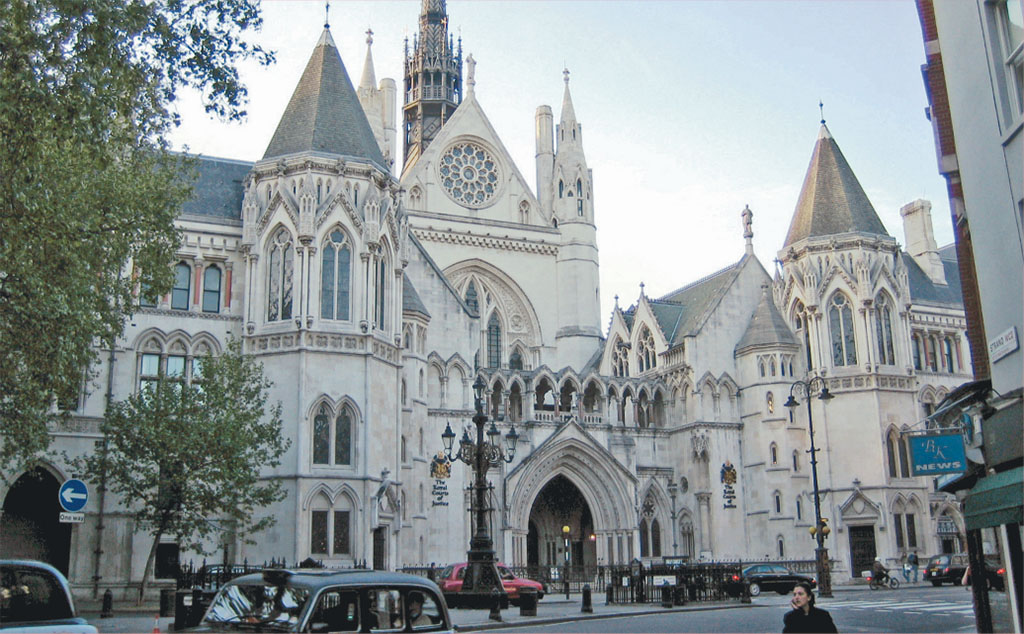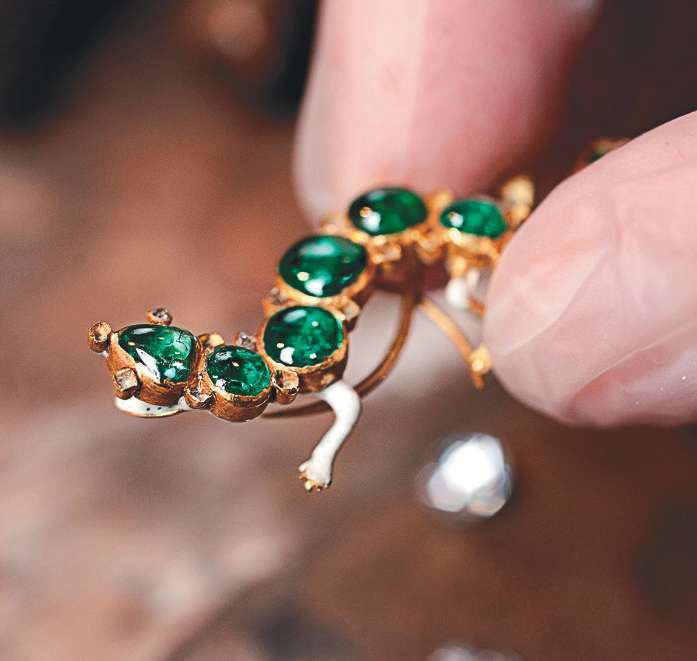
[caption id="AHatTrickofExhibitions&aBiteofTapas_img1" align="aligncenter" width="198"]

[caption id="AHatTrickofExhibitions&aBiteofTapas_img2" align="aligncenter" width="1024"]

ABOVE: ANTHONY MAJANLAHTI; ABOVE RIGHT: MUSEUM OF LONDON; RIGHT: REPRODUCED BY PERMISSION OF THE MARQUESS OF SALISBURY, HATFIELD HOUSE
WHAT I LOVE ABOUT LONDON is that no matter how weird you think the last weird thing was you discovered in the City, there’s always something weirder. I was reading a London-set fantasy novel, Sixty One Nails, where author Mike Shevdon describes a ritual so bloomin’ arcane I thought it must actually exist. It took some digging to discover not only does the Quit Rents ceremony exist, but it has done so since 1211, and it’s the oldest legal ceremony apart from the coronation. It is performed annually, alongside major criminal cases, at the Royal Courts of Justice in the Strand, with the usual British combination of deadpan humor and pride in tradition.
During the ritual, the City of London pays a token or “quit” rent for two parcels of land. Of course, no one actually knows where the two plots in question are, though one is near Bridgenorth in Shropshire, the other was once a forge somewhere near the Strand. For the Shropshire land the rent is two knives, their cutting capabilities to be tested against a hazel rod. For the city plot, the fee is six horseshoes and 61 nails.
The knives are forged new each year by the Worshipful Company of Cutlers, but the shoes date back to 1361, gigantic crescents intended for tournament horses. All are solemnly placed on a large, checked cloth, from which the term “exchequer” comes. Presiding over this strange scene is The Queen’s Remembrancer, resplendent in black robes, lace cravat and a classic 18th-century wig with a tricorn hat perched on top. The public is allowed to watch from the gallery as the Great and the Good, mainly Freemen of the City of London, gather below then repair to the secretive Middle Temple for a slap-up banquet.
Sadly, cameras are not allowed in the courts and despite its colorful pageantry, the ceremony has never been recorded in any format, which is possibly why I’d never heard of it. Perhaps no one else had either; there were six of us in the gallery for this extraordinary event. It generally takes place each October, is free to attend and tickets are not required.
BACK IN 1912, workmen demolishing a house in Cheapside made an extraordinary discovery: literal buried treasure. It turned out to be a 17th-century jeweller’s stock in trade, probably buried during the English Civil War. Almost overnight the find became a worldwide sensation, which makes it all the odder that it has taken 101 years to mount a full exhibition.
Perhaps it was the outbreak of war in 1914 that made the treasure slip people’s minds. For years I used to visit ‘the hoard’ in the Museum of London: exquisite jewels, delicate chains and fabulous set-pieces in a large glass cabinet. I was quite content with that and thought it a fine discovery. I was absolutely flabbergasted when I walked into the MoL’s new exhibition: “Cheapside Hoard—London’s Lost Jewels,” and saw two entire rooms full of treasure.
The sheer variety of jewelery, mainly Elizabethan and Stuart, but also comprising ancient Roman and Egyptian pieces, unworked stones and empty settings, is staggering. Hat pins, pomanders, brooches, clips and even a Tudor pocket watch made from the biggest emerald I have ever seen. Very, very highly recommended.
The sheer splendor of the Cheapside Hoard is a shame in some ways as I also visited two other exhibitions, both of which I would normally have raved about. “Elizabeth I and her People,” at the National Portrait Gallery, is a remarkable collection of paintings of Tudor citizens, ranging from humble servants through to the Virgin Queen herself. There are famous paintings I had only seen in books juxtaposed beautifully with obscure gems, thoughtfully presented to give a fascinating overview of society in this most glamorous of periods.
[caption id="AHatTrickofExhibitions&aBiteofTapas_img3" align="aligncenter" width="336"]

Over at the British Museum, their latest big-hitter continues the treasure theme, with a magnificent display of ancient bling: “Beyond El Dorado: Power and Gold in Ancient Colombia.” Putting the legends into context, it explores the way gold was used by pre-Hispanic Columbians, and how it was romanticized by their invaders. The rooms glow golden and every cabinet reveals yet more extraordinary treasure. World-class exhibitions are, as we say over here, like buses. You wait ages and then three come along at once.
I’VE NEVER BEEN ABLE to resist experimental theater that has a point, so I was intrigued by an email sent to our Esteemed Editor by a theater company with the unlikely sounding name “The Owle Schreame.” They exist to explore obscure medieval and renaissance theater, both texts and practice, and take pride in rediscovering works that have either never been performed or are as rare as, well, owls’ teeth.
What attracted me to The Cannibal Valour of Bussy D’Ambois, by George Chapman, was the fact that it was being performed inside the church under which the poet who had written it was buried. So the actors were, literally, at one point, dancing on their playwrights’ grave.
I saw the very first performance, which must have been a baptism of fire since that day had been the first time the actors had been together in one room, let alone rehearsed together. The director, Brice Stratford (who played Bussy himself), chose to rehearse the actors individually or in very small groups and bring them together on the night. Had I not read this in the program beforehand, I wouldn’t have known how it was produced, so smoothly it was performed.
[caption id="AHatTrickofExhibitions&aBiteofTapas_img4" align="alignleft" width="697"]

THIS MONTH’S CONTACTS
Quit Rents Ceremony
www.justice.gov.uk
London’s Lost Jewels
www.museumoflondon.org.uk
Elizabeth I and Her People
www.npg.org.uk
Beyond El Dorado
www.britishmuseum.org
The Owles Schreame
www.theowleschreame.com
Condesa
www.condesalondon.com
It’s brave stuff, not least in the staging; sword fights mere inches from audience members’ heads, in-the-round performance areas and disturbing torture and devil-conjuring scenes that I found all the more uncomfortable for being inside a church. Although I’m not convinced Owle Schreame have discovered a lost masterpiece, I was impressed by the performance, intend to see the other two previously unperformed, 300-year-old plays this season, and to seek out whatever Owle Schreame unearth next.
I’D AGREED TO MEET my friend Fiona for an after-hours natter at the Maple Leaf, a Canadian-themed pub in Maiden Lane, Covent Garden. In the past, it has always proved a good general meeting place for pals, but we were disappointed to discover it’s become a sports bar, with giant TV screens obliterating what used to be quirky, moose-ish charm. After one drink we decamped to Condesa, a new tapas bar almost opposite. A tiny, narrow bar, it manages to combine both modern and cozy, which is a rare achievement. I understand it also has live Rhumba on Sundays, which given the size of the place is an even greater feat. We enjoyed a nice range of classic Iberian dishes in friendly, atmospheric darkness (bring glasses for reading the menu!) though, as is traditional with Latin food, the menu was very meat-heavy. There was a good range of wines, mainly of Spanish origin, but it came in disappointingly small glasses for the price and it would be better just to order a bottle.
Next time I’ll be joining a bunch of London historians, listening to poetry in Southwark and testing a testing museum, whatever one of those might be….





Comments